How To Prevent Water Belly In Chickens
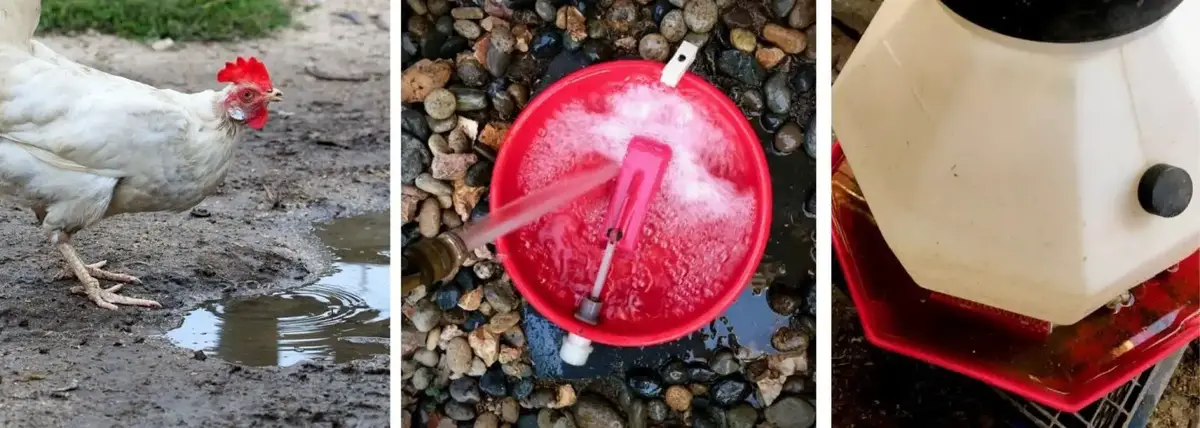
Chickens will beverage dirty h2o containing poop and pine shavings. But they really do adopt to consume clean water and will potable more of it, if it's provided for them.
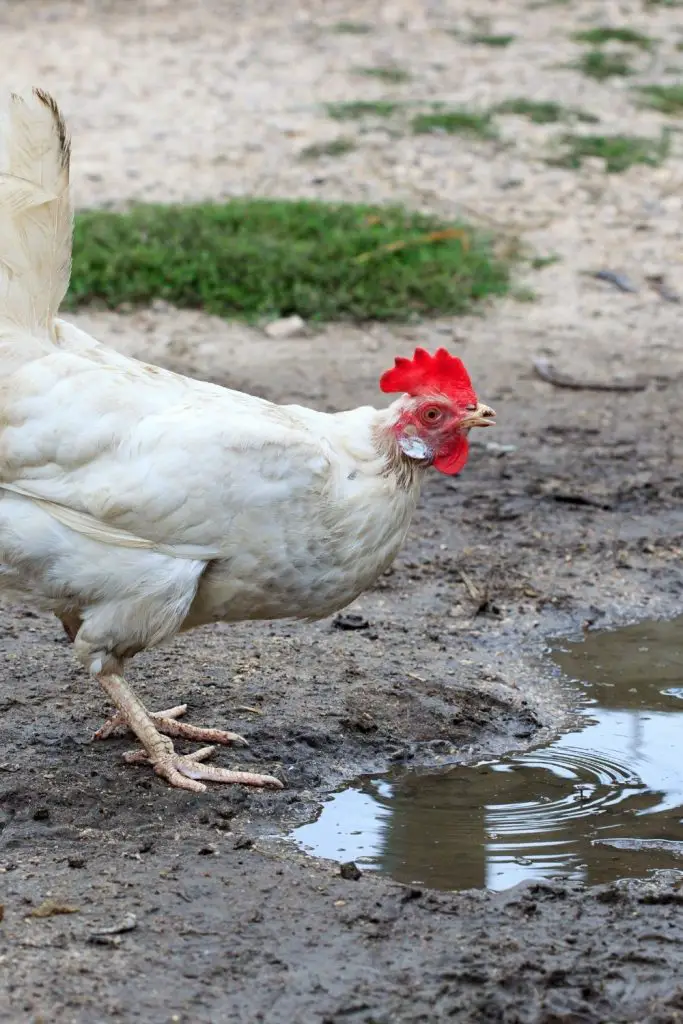
The average adult chicken drinks about a quart of water a day and up to twice this amount during hot weather. Information technology is important to provide your flock with enough fresh, cool, clean h2o on a daily basis.
For more helpful tips on how to keep your chickens cool during the hot weather, read my article 17 Tips – How to Keep Chickens Absurd in Farthermost Estrus.
i. How Oftentimes Should I Change My Craven'due south Water?
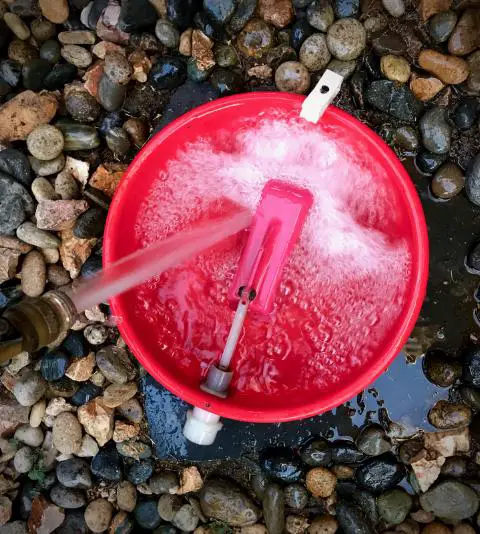
Chickens tin can make a mess of their water chop-chop, especially if it is in a location that is subject to filling with dirt and bedding when they are dust bathing or scratching the basis, foraging for food. It is always best to dump chicken water out daily(water your plants with it) instead of topping off.
- If chicken water looks dingy, it needs to be changed out.
- Babe chicks water needs to be cleaned and replenished multiple times, daily. Chicks are good at messing up their water!
- Large chicken waterers that tin can provide water for your flock for more than one day are fine to simply spray the troughs out daily and change out completely every other day. This will foreclose mold and algae from growing inside of information technology.
- Waterers should be given a good scrubbing for sanitization at least once a week, more frequently if it has any visible growth in it.
- During hot weather, waterers may need to be replenished multiple times daily and scrubbed daily too. Mold grows quicker in the estrus, especially if waterers are out in the directly sunlight whatever part of the day.
PRO TIP: Identify your craven waterers up at your smallest chicken's shoulder level, to decrease the amount of dirt and debris being kicked in it.
PRO TIP: Employ night containers for your waterers to cake the lord's day. This will slow down algae growth.
PRO TIP: Identify your chicken waterers in the shade. This not merely will provide cooler h2o for your chickens, merely it volition besides cut downwards on algae growth.
2. How to Sanitize a Plastic Chicken Waterer
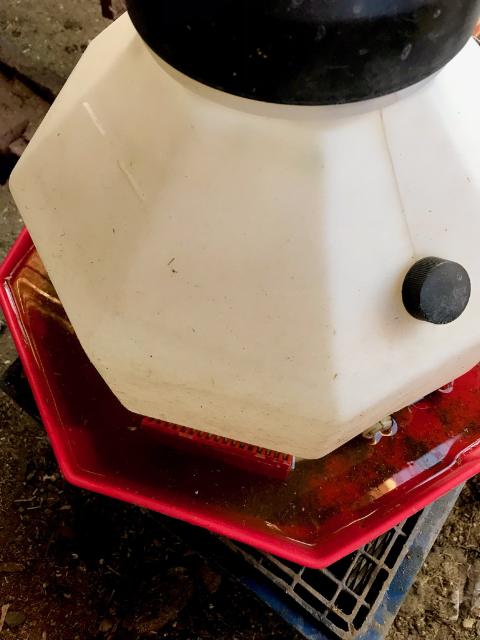
Chicken waterers should be cleaned daily and thoroughly sanitized at least weekly. The all-time fashion to sanitize your chicken waterers is to use apple cider vinegar, h2o and a good scrub brush. An alternative to using ACV is using liquid bleach.
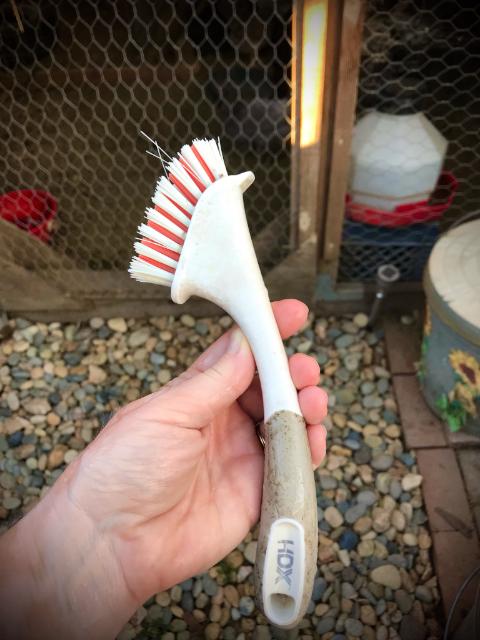
- Become a scrub brush that can fit into all the small troughs and crevices of your waterer. I notice that a narrow scrub brush works well for this.
- For a 5 gallon waterer, add 1 TBS of either ACV or liquid bleach to the plastic waterer and 1 gallon of water. I also proceed a mixture of this in a spray canteen and utilise this for spraying the outside of the containers. For smaller waterers, just brand upwards less cleaning solution.
- i TBS ACV or bleach to 1 Gallon Water
- i/ii TBS ACV or bleach to ane/2 Gallon Water
- ane/iv TBS ACV or bleach to 1/4 Gallon H2o
- Add together the appropriate amount of water to your container.
- Spray the outside of the container with a spray bottle containing the same solution.
- Employ your scrub brush and thoroughly scrub every nook and cranny of the container. Do the same for the outside.
- Requite information technology a proficient spray with your garden hose or sprayer to rinse out all of the dirt, algae and debris. Rinse information technology well to make sure y'all exercise not have any rest odor of ACV or bleach solution.
- I like to give information technology ane more than spray using ACV and water solution and prepare information technology out in the hot dominicus for a expert x-xv minutes to kill any more bacteria that may still be lingering.
- Give information technology a final rinse and fill information technology up with cool, clean water for your flock.
three. How to Sanitize a Metal Chicken Waterer
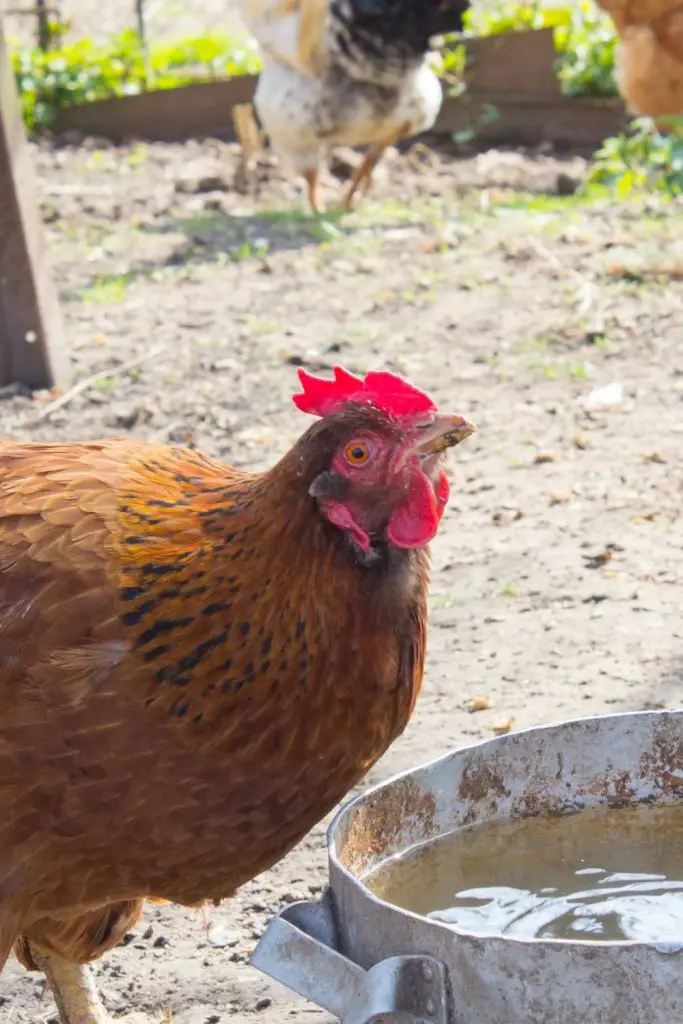
Metallic craven waterers are often made out of double coated galvanized steel. The best manner to sanitize a metallic watering container is by using hot or very warm water, balmy dish soap and a soft sponge.
You do not desire to use annihilation acidic, such equally ACV. If you want to add apple cider vinegar to the chickens water for increasing their probiotics, apply a plastic waterer.
Don't use bleach inside a metallic container for your chickens either. Using ACV or bleach can crusade information technology to rust, releasing harmful particles into the h2o.
Don't use steel wool or a harsh scrub castor. It volition intermission down the surface of the container, assuasive it to be more susceptible to rusting and releasing the toxic metallic zinc into the water.
- Rinse metallic craven waterer with hot or very warm water.
- Add 1 tsp. of mild dish soap.
- Utilize a soft sponge to scrub away whatsoever slime or algae.
- Rinse off and refill with cool, clean water for your flock.
iv. Should Y'all Put Anything in Your Chicken'south Water?
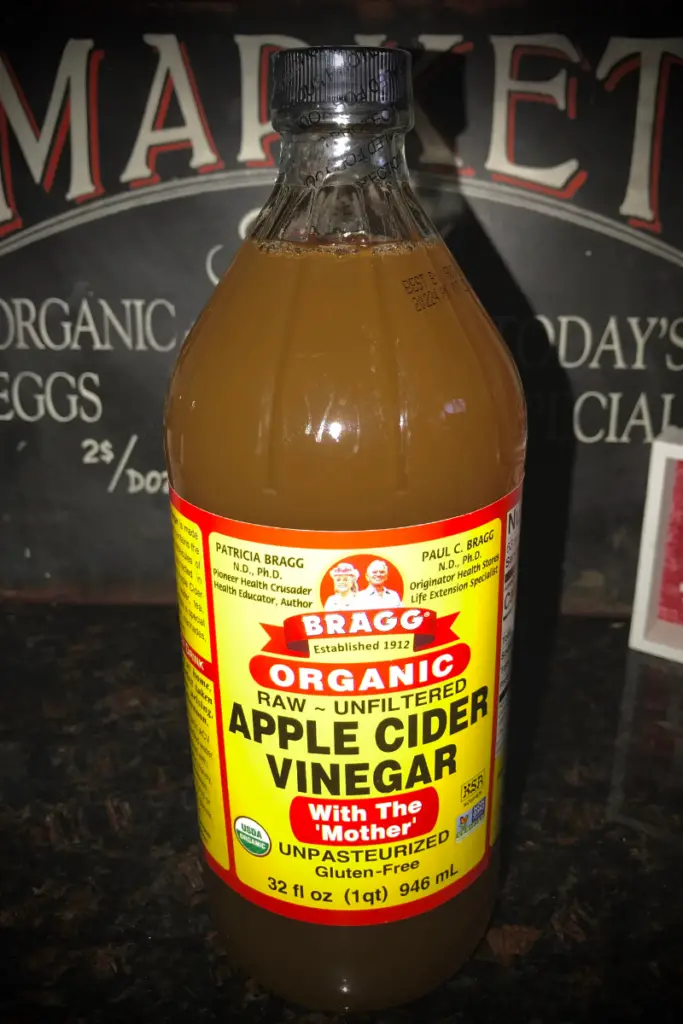
Adding apple cider vinegar to PLASTIC waterers. Information technology is ok to add together ane TBS of h2o for each gallon of your chicken's water up to a week at a time, but no more once a month. This volition assistance to continue algae from forming in the chicken waterer.
WARNING: You shouldn't add ACV to METAL waterers. Due to the acidity of the apple cider vinegar it can react with certain types of metal, causing it to leech zinc, which is very toxic to birds.
Metal chicken waterers should be routinely checked for whatever corrosion. Chickens are very curious to anything shiny so are at risk of ingesting odds and end items it sees. Many shiny objects contain zinc such every bit screws, nuts, bolts, jewelry, zippers, pennies, etc.
Be extra careful not to leave whatsoever of your hardware cloth clippings around where chickens visit. This besides contains zinc.
Alarm: Do not add bleach to your chicken waterer to prevent algae or bacterial growth. Putting bleach in your chickens daily drinking water tin be harmful to your chickens. It can break downward your plastic and galvanized metallic waterers, releasing harmful chemicals into the drinking water.
For more than benign means you tin use ACV in and around your chicken coop, read my article 12 Unique Benefits of ACV Around Your Chicken Coop. See beneath.
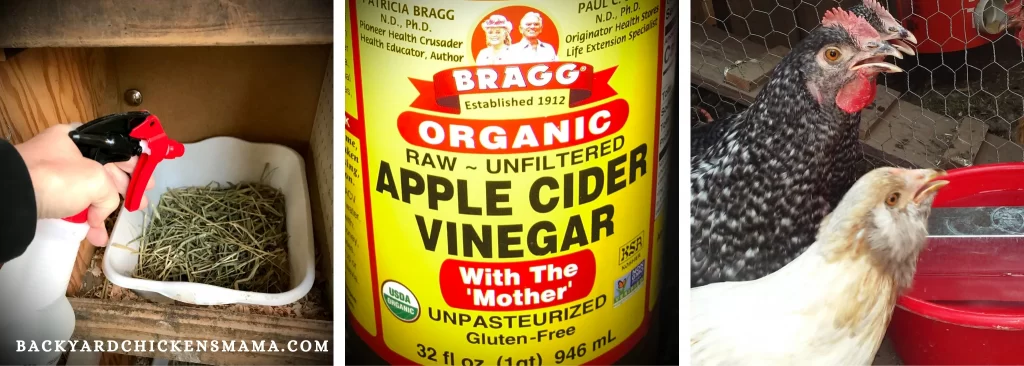
Zinc Toxicity from Metallic Waterers
| SYMPTOMS OF ZINC TOXICITY IN CHICKENS |
|---|
| LOSS OF BALANCE |
| FALLING |
| INCREASED URINATION |
| INCREASED THRIST |
| VERY WEAK |
| PARALYSIS OF LEGS |
| Pale COMB AND WATTLE |
| ANEMIA |
| WEIGHT LOSS |
v. How to Continue Craven Waterer from Growing Algae
- Changing your chicken h2o out more often will terminate algae from growing.
- Keep your chicken waterers out of directly sunlight. Algae will abound quicker in straight sunlight.
- Store craven water in a dark container that doesn't allow sunlight in.
- In one case a month, for one week, add 1 TBS of apple cider vinegar per gallon of water to your chicken'south water. The acerbity of the ACV will tiresome the growth of algae.
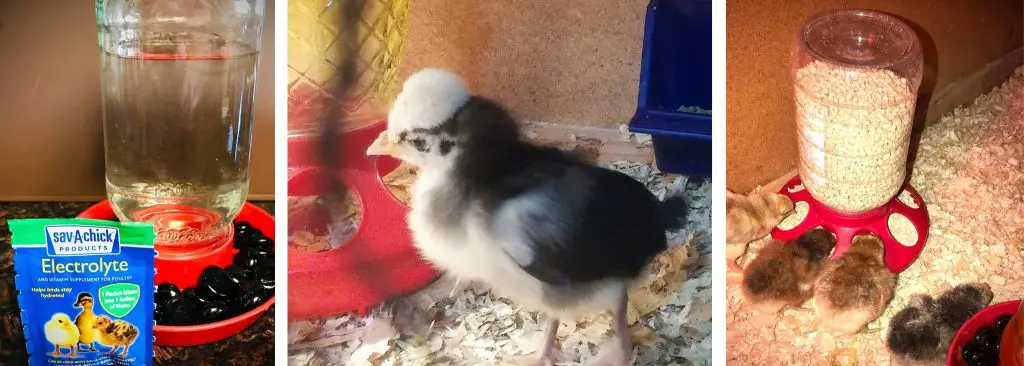
6. How to Go along Baby Chick Waterers Clean
Infant chicks similar to perch up on top of their waterers. They feel more secure, the in a higher place they are and roosting on top of a chick waterer is the perfect height for them! Unfortunately, perching upwardly top here ways all of the poop falls straight into the water below them.
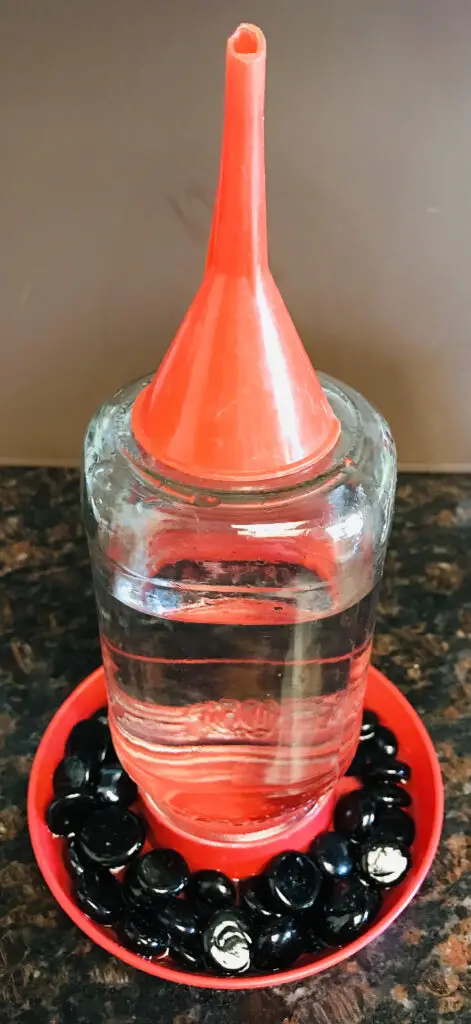
PRO TIP: Identify a small funnel on superlative of the baby chicks food and water containers to deter them from perching. This will stop them from pooping into the water.
PRO TIP: Provide areas for chicks to perch that are higher upwardly. This manner they will be less probable to try to get on elevation of their watering containers.
Chicks are notorious for boot upwardly their bedding and filling their water with it! I have plant the best solution is to make them a raised surface area, with a screen flooring and without bedding, that they can become to their feed and water.
An alternative to this is placing your chicks water off to the side, just on the outskirts of their oestrus source. As well, make sure that information technology is raised up off the ground, but no higher than shoulder level for your smallest chick. This manner they are less likely to boot bedding into it…..well, as much bedding into information technology.
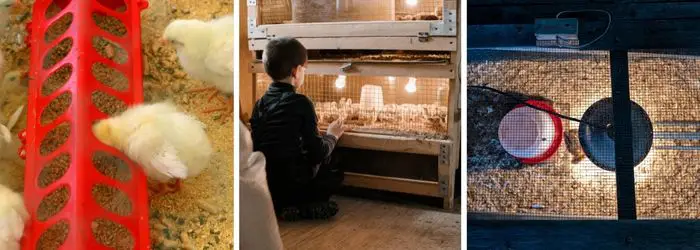
7. How to Identify Mortiferous Blue-Green Algae
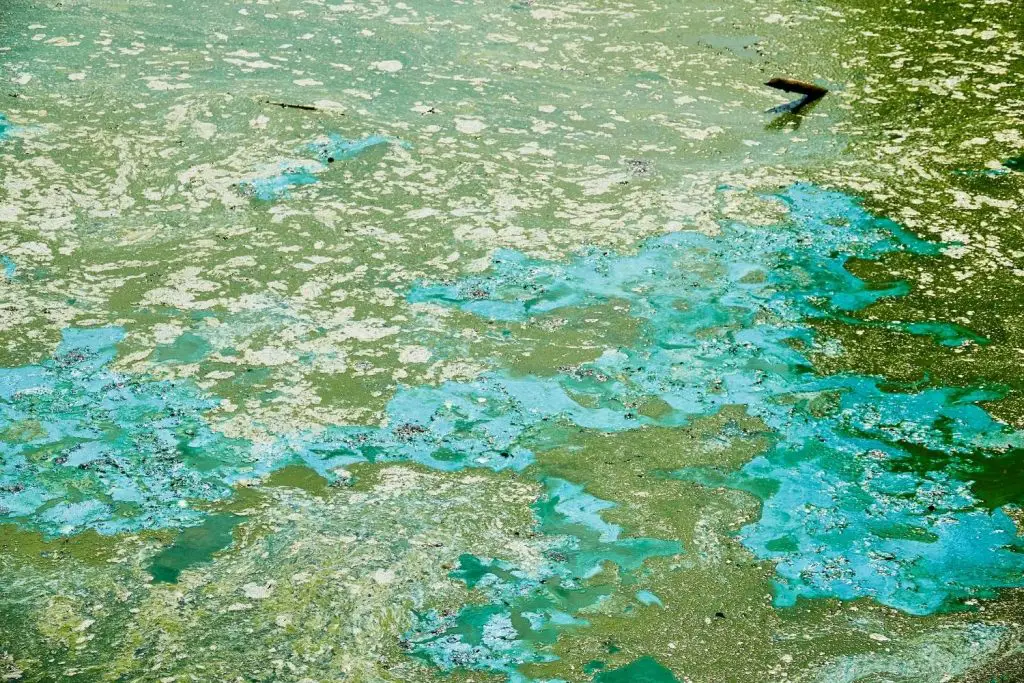
Chickens that are allowed to free range on properties that contain creek beds, lakes, ponds or brackish water need to be aware of the deadly blue-green algae.
While not every bit mutual, it tin also develop in chicken waterers, buckets and baby pools that have been stagnant (not cleaned) and exposed to hot temperatures and sunshine. This is something that you lot tin control by stepping upwardly on your daily and weekly cleaning.
For those that allow your flock to gratis-range, is important to be able to identify this algae so you can go on your flock away from it.
- Blue-green algae is a 'cyanobacteria' ordinarily found in shallow areas of creek beds, lakes, ponds and brackish waters.
- Information technology is bluish or greenish in color and looks like scum or a mat on top of the surface of the water.
- Sometimes it tin can look like cream at the shoreline or even similar someone took a tin of green or blue paint and threw information technology into the h2o.
- Blue-dark-green algae prefers warm, calm, shallow waters. This is why information technology is usually seen at the edges of creek beds, lakes, ponds or brackish waters.
Some blue-light-green algae, only not all, tin can produce hepatotoxins and neurotoxins that if ingested tin cause organ and nervous organisation damage and tin can even crusade death. You cannot tell just by looking at blue-dark-green algae if information technology is the toxic kind. Then if you lot spot it on your property, you lot should take a sample of the water tested.
"Harmful algae and blue-green alga (sometimes called blue-light-green algae) tin can produce toxins (poisons) that tin make people and animals sick and touch on the surround. Learn more about them to keep you and your pets prophylactic."
CDC
It doesn't accept much hepatotoxins for a chicken to ingest to begin to cause liver failure. The more that a craven ingests, the quicker the death. Death volition unremarkably occur within 24 hours.
If y'all chicken ingests neurotoxins, death sill usually occur within 30-60 minutes.
| TOXIN | SYMPTOMS OF BLUE-Light-green ALGAE POISONING IN CHICKENS |
|---|---|
| HEPATOTOXIN | Stake COMB/ ORGAN FAILURE Decease Inside 24 HOURS |
| HEPATOTOXIN | WEAKNESS Decease WITHIN 24 HOURS |
| HEPATOTOXIN | BLOODY DIARRHEA Death WITHIN 24 HOURS |
| HEPATOTOXIN | DARK POOP Expiry Inside 24 HOURS |
| NEUROTOXIN | PURPLE Rummage/ DEATH Within 30-sixty MINUTES |
| NEUROTOXIN | RESPIRATORY DISTRESS/ Expiry WITHIN xxx-threescore MINUTES |
| NEUROTOXIN | TREMORS/ Death WITHIN xxx-60 MINUTES |
| NEUROTOXIN | PARALYSIS/ DEATH Inside 30-60 MINUTES |
| NEUROTOXIN | SEIZURES/ DEATH WITHIN 30-60 MINUTES |
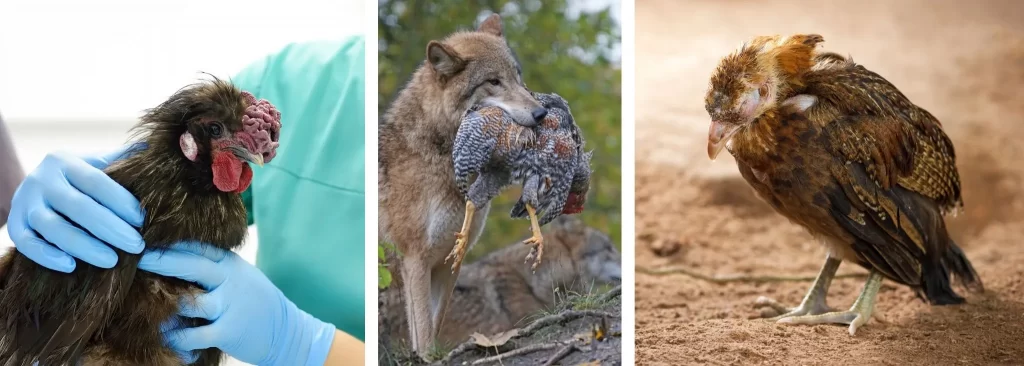
Determination: How to Go along Chicken Water Clean
Chickens will drink muddied h2o if it is in front of them, even if information technology contains poop, algae, droppings, etc. Equally a craven owner, it is our responsibility to brand sure that we provide them with make clean, cool, fresh water daily.
Chicken waterers should exist cleaned daily and sanitized appropriately on a weekly basis. This will help to command bacterial and algae growth.
Never add together harsh chemicals similar bleach to the drinking h2o because it can cause both plastic and metal waterers to intermission down, releasing harsh chemicals into the water.
If yous have free ranging chickens be aware of blue-green algae. This includes buckets and babe pools with stagnant h2o that you accept out on your holding or if you lot have bodies of water such equally a creek bed, pond, lake or whatever type of stagnant h2o.
If you lot think y'all accept blue-green algae on your holding get a sample of the water tested and keep your chickens away until you know it is safe.
Source: https://www.backyardchickensmama.com/how-to-keep-chicken-water-clean/


0 Response to "How To Prevent Water Belly In Chickens"
Post a Comment